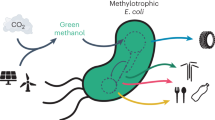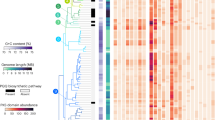Abstract
Two distinct microbial processes, denitrification and anaerobic ammonium oxidation (anammox), are responsible for the release of fixed nitrogen as dinitrogen gas (N2) to the atmosphere1,2,3,4. Denitrification has been studied for over 100 years and its intermediates and enzymes are well known5. Even though anammox is a key biogeochemical process of equal importance, its molecular mechanism is unknown, but it was proposed to proceed through hydrazine (N2H4)6,7. Here we show that N2H4 is produced from the anammox substrates ammonium and nitrite and that nitric oxide (NO) is the direct precursor of N2H4. We resolved the genes and proteins central to anammox metabolism and purified the key enzymes that catalyse N2H4 synthesis and its oxidation to N2. These results present a new biochemical reaction forging an N–N bond and fill a lacuna in our understanding of the biochemical synthesis of the N2 in the atmosphere. Furthermore, they reinforce the role of nitric oxide in the evolution of the nitrogen cycle.
This is a preview of subscription content, access via your institution
Access options
Subscribe to this journal
Receive 51 print issues and online access
$199.00 per year
only $3.90 per issue
Buy this article
- Purchase on Springer Link
- Instant access to full article PDF
Prices may be subject to local taxes which are calculated during checkout




Similar content being viewed by others
Accession codes
Data deposits
The metatranscriptome and peptidome sequences are deposited in Gene Expression Omnibus under accession numbers GSE15408 and PSE111, respectively.
References
Arrigo, K. R. Marine microorganisms and global nutrient cycles. Nature 437, 349–355 (2005)
Brandes, J. A., Devol, A. H. & Deutsch, C. New developments in the marine nitrogen cycle. Chem. Rev. 107, 577–589 (2007)
Payne, W. J. Reduction of nitrogenous oxides by microorganisms. Bacteriol. Rev. 37, 409–452 (1973)
Strous, M. et al. Missing lithotroph identified as new planctomycete. Nature 400, 446–449 (1999)
Zumft, W. G. Cell biology and molecular basis of denitrification. Microbiol. Mol. Biol. Rev. 61, 533–616 (1997)
Strous, M. et al. Deciphering the evolution and metabolism of an anammox bacterium from a community genome. Nature 440, 790–794 (2006)
Van de Graaf, A. A., deBruijn, P., Robertson, L. A., Jetten, M. S. M. & Kuenen, J. G. Metabolic pathway of anaerobic ammonium oxidation on the basis of N-15 studies in a fluidized bed reactor. Microbiology 143, 2415–2421 (1997)
Kartal, B. et al. Candidatus ‘Brocadia fulgida’: an autofluorescent anaerobic ammonium oxidizing bacterium. FEMS Microbiol. Ecol. 63, 46–55 (2008)
Kartal, B., Geerts, W. & Jetten, M. S. M. Cultivation, detection and ecophysiology of anaerobic ammonium-oxidizing bacteria. Methods Enzymol. 486, 89–108 (2011)
Van der Star, W. R. L. et al. The membrane bioreactor: a novel tool to grow anammox bacteria as free cells. Biotechnol. Bioeng. 101, 286–294 (2008)
Keller, M. & Hettich, R. Environmental proteomics: a paradigm shift in characterizing microbial activities at the molecular level. Microbiol. Mol. Biol. Rev. 73, 62–70 (2009)
Akaike, T. & Maeda, H. Quantitation of nitric oxide using 2-phenyl-4,4,5,5-tetramethylimidazoline-1-oxyl 3-oxide (PTIO). Methods Enzymol. 268, 211–221 (1996)
Guo, F. Q., Okamoto, M. & Crawford, N. M. Identification of a plant nitric oxide synthase gene involved in hormonal signaling. Science 302, 100–103 (2003)
Nagano, T. Practical methods for detection of nitric oxide. Luminescence 14, 283–290 (1999)
Gilch, S., Vogel, M., Lorenz, M. W., Meyer, O. & Schmidt, I. Interaction of the mechanism-based inactivator acetylene with ammonia monooxygenase of Nitrosomonas europaea . Microbiology 155, 279–284 (2009)
Hyman, M. R. & Wood, P. M. Suicidal inactivation and labeling of ammonia mono-oxygenase by acetylene. Biochem. J. 227, 719–725 (1985)
McTavish, H., Fuchs, J. A. & Hooper, A. B. Sequence of the gene coding for ammonia monooxygenase in Nitrosomonas europaea . J. Bacteriol. 175, 2436–2444 (1993)
Hooper, A. B. & Nason, A. Characterization of hydroxylamine-cytochrome c reductase from chemoautotrophs Nitrosomonas europaea and Nitrosocystis oceanus . J. Biol. Chem. 240, 4044–4057 (1965)
Hooper, A. B., Vannelli, T., Bergmann, D. J. & Arciero, D. M. Enzymology of the oxidation of ammonia to nitrite by bacteria. Anton. Leeuw. Int. J. G. Microbiology 71, 59–67 (1997)
Klotz, M. G. et al. Evolution of an octahaem cytochrome c protein family that is key to aerobic and anaerobic ammonia oxidation by bacteria. Environ. Microbiol. 10, 3150–3163 (2008)
Shimamura, M. et al. Isolation of a multiheme protein with features of a hydrazine-oxidizing enzyme from an anaerobic ammonium-oxidizing enrichment culture. Appl. Environ. Microbiol. 73, 1065–1072 (2007)
Shimamura, M. et al. Another multiheme protein, hydroxylamine oxidoreductase, abundantly produced in an anammox bacterium besides the hydrazine-oxidizing enzyme. J. Biosci. Bioeng. 105, 243–248 (2008)
Van Niftrik, L. et al. Intracellular localization of membrane-bound ATPases in the compartmentalized anammox bacterium ‘Candidatus Kuenenia stuttgartiensis’. Mol. Microbiol. 77, 701–715 (2010)
Ducluzeau, A. L. et al. Was nitric oxide the first deep electron sink? Trends Biochem. Sci. 34, 9–15 (2009)
Watt, G. W. & Chrisp, J. D. A spectrophotometric method for the determination of hydrazine. Anal. Chem. 24, 2006–2008 (1952)
Strous, M., Heijnen, J. J., Kuenen, J. G. & Jetten, M. S. M. The sequencing batch reactor as a powerful tool for the study of slowly growing anaerobic ammonium-oxidizing microorganisms. Appl. Microbiol. Biotechnol. 50, 589–596 (1998)
Kartal, B. et al. Effect of nitric oxide on anammox bacteria. Appl. Environ. Microbiol. 76, 6304–6306 (2010)
Rappsilber, J., Ishihama, Y. & Mann, M. Stop and go extraction tips for matrix-assisted laser desorption/ionization, nanoelectrospray, and LC/MS sample pretreatment in proteomics. Anal. Chem. 75, 663–670 (2003)
Wilm, M. et al. Femtomole sequencing of proteins from polyacrylamide gels by nano-electrospray mass spectrometry. Nature 379, 466–469 (1996)
Audrieth, L. F. & Ackerson Ogg, B. The Chemistry of Hydrazine (Wiley, 1951)
Schmid, M. et al. Molecular evidence for genus level diversity of bacteria capable of catalyzing anaerobic ammonium oxidation. Syst. Appl. Microbiol. 23, 93–106 (2000)
Schmid, M. C. et al. Biomarkers for in situ detection of anaerobic ammonium-oxidizing (anammox) bacteria. Appl. Environ. Microbiol. 71, 1677–1684 (2005)
Van de Graaf, A. A., de Bruijn, P., Robertson, L. A., Jetten, M. S. M. & Kuenen, J. G. Autotrophic growth of anaerobic ammonium-oxidizing micro-organisms in a fluidized bed reactor. Microbiology 142, 2187–2196 (1996)
Laemmli, U. K. Cleavage of structural proteins during assembly of head of bacteriophage-T4. Nature 227, 680–685 (1970)
Candiano, G. et al. Blue silver: A very sensitive colloidal Coomassie G-250 staining for proteome analysis. Electrophoresis 25, 1327–1333 (2004)
Farhoud, M. H. et al. Protein complexes in the archaeon Methanothermobacter thermautotrophicus analyzed by blue native/SDS-PAGE and mass spectrometry. Mol. Cell. Proteomics 4, 1653–1663 (2005)
Ishihama, Y., Rappsilber, J., Andersen, J. S. & Mann, M. Microcolumns with self-assembled particle frits for proteomics. J. Chromatogr. A 979, 233–239 (2002)
Weatherly, D. B. et al. A heuristic method for assigning a false-discovery rate for protein identifications from mascot database search results. Mol. Cell. Proteomics 4, 762–772 (2005)
Neuhoff, V., Arold, N., Taube, D. & Ehrhardt, W. Improved staining of proteins in polyacrylamide gels including isoelectric-focusing gels with clear background at nanogram sensitivity using coomassie brilliant blue G-250 and R-250. Electrophoresis 9, 255–262 (1988)
Mortz, E., Krogh, T. N., Vorum, H. & Gorg, A. Improved silver staining protocols for high sensitivity protein identification using matrix-assisted laser desorption/ionization-time of flight analysis. Proteomics 1, 1359–1363 (2001)
Calvaruso, M. A., Smeitink, J. & Nijtmans, L. Electrophoresis techniques to investigate defects in oxidative phosphorylation. Methods 46, 281–287 (2008)
Acknowledgements
B.K. was supported by a grant (05987) from the Dutch Foundation for Applied Research. W.J.M. was supported by a grant (142161201) from the Darwin Center for Biogeosciences. N.M.d.A. and I.C. were supported by a grant (81802015) from the Netherlands Organization for Scientific Research. M.S. was supported by a VIDI grant from the Netherlands Organization for Scientific Research and a European Research Council grant MASEM (242635). The anammox research of M.S.M.J. is supported by an advanced grant (232987) from the ERC. The authors acknowledge R. Klefoth for the initial tests for protein purification procedures.
Author information
Authors and Affiliations
Contributions
Physiological experiments were conceived, designed and performed by B.K., Kuenenia stuttgartiensis was grown by B.K. and W.G., two-dimensional gel electrophoresis was performed by N.M.A. and I.C., one-dimensional gel electrophoresis was performed by W.J.M. and B.K., MALDI–TOF analysis was performed by B.K., W.J.M. and H.J.M.O.d.C., nanoLC-MS/MS by J.G., RNA extraction and reverse transcription by H.R.H., Illumina sequencing by E.M.J.-M., K.-J.F. and H.S., and protein purification and activity tests were designed by W.J.M., B.K. and J.T.K. and performed by W.J.M. Proteomic and transcriptomic data processing was performed by J.G., M.S., K.-J.F., B.K., M.S.M.J. and H.J.M.O.d.C. The manuscript was written by B.K. with input from J.T.K., M.S. and M.S.M.J.
Corresponding author
Ethics declarations
Competing interests
The authors declare no competing financial interests.
Supplementary information
Supplementary Information
The file contains Supplementary Figures 1-3 with legends and Supplementary Table 1. (PDF 1410 kb)
Rights and permissions
About this article
Cite this article
Kartal, B., Maalcke, W., de Almeida, N. et al. Molecular mechanism of anaerobic ammonium oxidation. Nature 479, 127–130 (2011). https://doi.org/10.1038/nature10453
Received:
Accepted:
Published:
Issue Date:
DOI: https://doi.org/10.1038/nature10453
This article is cited by
-
A loading rate switch strategy for stable nitritation in mainstream municipal wastewater
Nature Sustainability (2024)
-
Anammox with alternative electron acceptors: perspectives for nitrogen removal from wastewaters
Biodegradation (2024)
-
Nitrogen transformation processes catalyzed by manure microbiomes in earthen pit and concrete storages on commercial dairy farms
Environmental Microbiome (2023)
-
Hot moment of N2O emissions in seasonally frozen peatlands
The ISME Journal (2023)
-
Enrichment and characterization of a nitric oxide-reducing microbial community in a continuous bioreactor
Nature Microbiology (2023)
Comments
By submitting a comment you agree to abide by our Terms and Community Guidelines. If you find something abusive or that does not comply with our terms or guidelines please flag it as inappropriate.



